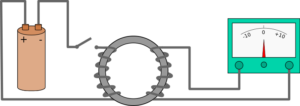Table of Contents
Electromagnetic induction, as well known as induction, is a process in which a conductor is placed in a specific position and the magnetic field varies, or the magnetic field is stationary and the conductor moves. It thus causes a voltage or EMF (Electromotive Force) to be generated across the electrical conductor.
Michael Faraday discovered electromagnetic induction in 1831, and James Clerk Maxwell mathematically described it as Faraday’s law of induction. He set up a lead wire, which he connected to a device that measured the voltage across the circuit. Whenever a bar magnet passes through the snaking, the voltage in the circuit is measured.
The significance of this is that it is a method of producing electrical energy in a circuit by using magnetic fields rather than batteries. Equipment such as generators, transformers, and motors operate on this principle.
Electromagnetic induction is indeed the generation of a current as a result of voltage generation (electromotive force) caused by a changing magnetic field. It occurs when a conductor is placed in a moving magnetic field (when using an alternating current power source) or when a conductor is constantly moving in a stationary magnetic field.
During his experiment, he discovered that certain factors influence voltage production. They are as follows:
- No of Coils: The induced voltage seems to be proportional to the number of wire turns/coils. The greater the number of turns, the higher the voltage produced.
- Changing Magnetic Field: The induced voltage has been affected by changes in the magnetic field. This can be accomplished by moving the magnetic field around the conductor or by moving the conductor within the magnetic field.

Electromagnetic Induction Formula
The induced voltage can be calculated mathematically using the following relationship:
e = N × dΦ / dt
Here,
- e is said to be the induced voltage (in volts).
- N is said to be the number of turns in the coil.
- Φ is considered as the magnetic flux – the amount of magnetic field at a surface (in Webbers).
- t stands for the time (in seconds).
The relevance of this discovery is that it demonstrates a method of producing electrical energy in a circuit that does not rely on batteries. Each and everyday machines such as motors, generators, and transformers operate on this principle.
Applications of Electromagnetic Induction
Depending on his experiments, we now have Faraday’s law, which states that the amount of voltage induced in a coil is proportional to the number of turns and the rate at which the magnetic field changes.
- The principle of electromagnetic induction governs the operation of an alternating current generator.
- The electromagnetic induction principle underpins the operation of electrical transformers.
- The electromagnetic induction principle underpins the magnetic flow metre.
FAQs
What do mean by electromagnetic induction?
It's really the induction of an electromotive force in a circuit by varying the magnetic flux that is connected to the circuit.
What causes electromagnetic induction?
Electromagnetic induction is indeed the technical term for the phenomenon in which an electric current flows in a wire when it is moved near a magnet or when a magnet is moved near a wire.






